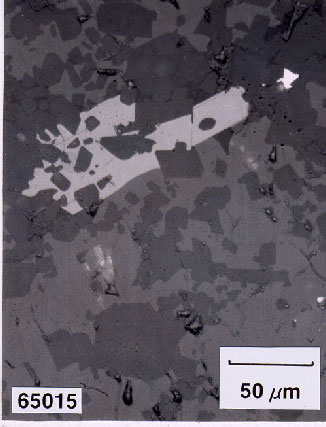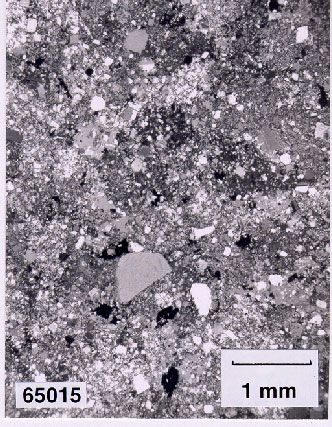
BRIEF DESCRIPTION OF 65015
| Lunar Sample Compendium Link | Lunar Sample Catalog Link | Open University Virtual Microscope Link |
Sample 65015 is an impact-melt breccia that was collected from the lunar highlands during the Apollo 16 mission. It is a very dense and coherent sample with distinctive poikilitic texture (fig. 50). It is clast-rich and holocrystalline and has been studied in detail by Albee et al. 1973. The age of the sample is about 3930 million years.
Figure 50. Partially polarized, transmitted-light photo of the poikiloblastic texture of the matrix of 65015. Small chadacrysts of plagioclase are poikilitically enclosed in large orthopyroxene oikocrysts which fit together like pieces of a jigsaw puzzle.

Figure 51. Reflected light photo of poikilitic ilmenite and orthopyroxene in 65015.
Matrix - Pigeonite oikocrysts are peppered with abundant equant chadacrysts of plagioclase and rare embayed chadacrysts of olivine and augite. Areas between oikocrysts contain irregular vug's, plagioclase laths, K-feldspar, phosphate, and troilite.
Clasts - Large plagioclase grains (1 mm) are included as the most abundant clasts. Various lithic clasts including polygonal anorthosite, gabbroic anorthosite, and intersertal basalts are present in some thin sections.
Glass - None.
Opaques - Ilmenite occurs predominantly as irregular poikilitic grains including plagioclase laths (fig. 51). It contains exsolution lamellae of rutile and Cr-rich spinel. Globules of metallic iron are present in some sections
Petrogenesis - The clast assemblage indicates that the protolith for this sample was a polymict mixture of highland rock types. The recrystallized matrix indicates that this sample is from a melt sheet of fallback breccia inside a relatively large lunar crater. It is thought that a mixture of both hot and cold fragmental material falls back into the crater, forming a lava lake that initially cools rapidly while the cold fragments are partially dissolved by the superheated hot melt. This initial quench prevents separation of phases such as metal iron or gas (voids). In this model, the quenched lava lake equilibrates slowly, forming the unusual poikilitic texture of the matrix. Rocks with this texture are found in the melt sheets in the centers of large terrestrial craters. The large boulders sampled at the Apollo 17 site also had this texture.

